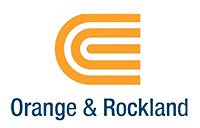
Orange and Rockland History
Orange and Rockland Electric Company dates back to 1859 when the Nyack and Warren Gas Company illuminated over 40 Nyack homes and businesses with manufactured ("coal") gas. The company later reorganized as the Nyack Gas and Light Fuel Company in 1872. But with electricity growing more popular, local investors formed the Nyack Electric Light and Power company in 1887 to provide businesses with arc-lighting and homes with incandescent light bulbs.
Just a few years later in the early 1890s, Stephen R. Bradely, president of the Union Electric Company in Brooklyn, came to Orangeburg to build a power plant. Thereafter, he built a factory next door to make "Orangeburg Pipe", a product that used compressed bituminized-wood pulp that was to make water-resistant electrical conduit and sewer pipe. The successful factory consumed a lot of electricity and steam so Bradley formed Rockland Light and Power Company in 1899 and bought out Nyack Electric Light and Power the following year. The company went on to improve operations throughout the Nyack area and into Rockland County.
To do so, the company hired a young and ambitious engineer, Roscoe W. Smith. But in 1905, Smith decided to go off and form the Orange Utilities Company in Chester in Orange County and soon built a 200 horsepower plant to serve nearby villages. Smith's company prospered, rapidly lining up franchises and buying other small utilities until growth forced it to reorganize in 1909 as the Orange and Rockland Electric Company. It then took over the old Nyack Gas Light and Fuel Company.
Meanwhile, the Charles H. Tenney Company of Boston had been investing in Rockland County electric companies since the 1890s. In 1912, it bought the Rockland Light and Power Company and merged its other Rockland County electric companies into it. Likewise, Tenney also sought to expand into neighboring Orange County. Not surprisingly, in 1924 it acquired Smith's firm, creating Orange and Rockland Electric Company as a subsidiary of Rockland Light and Power. Then in 1926, Tenney purchased Orange County Public Service and merged it into Rockland Light and Power Company. The company structure remained so until 1958 when Rockland Light and Power Company would finally consolidated with its subsidiary to become Orange and Rockland Utilities, Inc.
As a result of New York's electric deregulation in the late 1990s, Orange and Rockland had to reorganize into an electricity-distribution company by selling off its generating facilities. With increased competition for customers looming, Consolidated Edison moved to acquire Orange and Rockland for $790 million in 1998.
Today, Orange and Rockland Electric Company is an independent subsidiary of Con Edison and serves approximately 304,506 electricity customers and more than 130,000 natural gas customers in the Lower Hudson Valley. Orange and Rockland support several nonprofit organizations through partnerships, grants, and programs that help the communities in both their NY and NJ service areas.
Orange and Rockland Service Territory
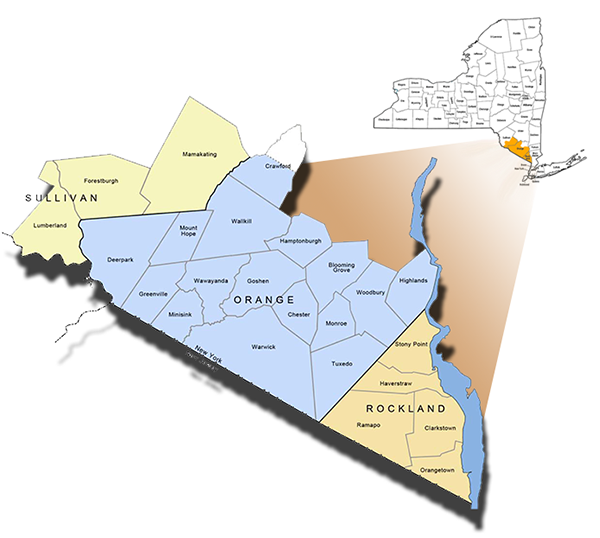
Orange and Rockland serves approximately 304,506 electricity customers in these Counties of New York's Lower Hudson Valley.
| Sullivan | Orange | Rockland |
Orange and Rockland serves these cities:
Shop Orange and Rockland Electricity Suppliers In Your Area.
Compare Orange and Rockland Electricity Rates
Compare alternative supplier electricity rates
in the Orange and Rockland service area.
- Enter zip code.
- Select "electricity".
- Choose "residential" or "business".
- Click "Shop for Rates".
In New York, electricity utility service territories may overlap in some zip codes. If the tool reports that it has found more than one serving your zip code, don't worry! Just choose your local utility from those listed.
You'll then get to see the listing of all the energy suppliers' plans available in your area, along with rates, term lengths, and links to more detail information.
How to Start New Orange and Rockland Service
Getting set up with Orange and Rockland is easy and convenient. Just visit the Orange and Rockland web site to start your electric service. If you don't have an account, you can register for one and then follow the prompts to set up your service.
Customers can also apply to start service by calling Orange and Rockland customer service (1-877-434-4100).
Be ready to supply:
- Service Address: The address where you want your service turned on or switched.
- The start date for electricity service.
- Personal Information: You will need to provide a valid form of identification (such as a driver's license or credit card) to validate your name and prior address. Otherwise, you will need to pay a deposit.
- The utility may also require proof of your occupancy date for service and ask you for a copy of your lease or deed.
Applicants for electric service must have paid in full all bills on their past Orange and Rockland accounts or agree to a deferred-payment plan before a new account can be opened. Orange and Rockland will notify you by letter within three business days after receiving your application if it has been denied. The letter will state the reason(s) for denial, exactly what you must do to be approved.
Will I Need to Pay a Deposit?
In New York, no utility can require any new residential customer to pay a security deposit as a condition of receiving utility service. The same applies to anyone over 62 year old. Lastly, if you receive public assistance, you will not need to pay a deposit.
However, the utility can require a deposit if:
- You're new seasonal or short-term customer.
- You are applying for a new Orange and Rockland account within 60 days of closing an old account and the bill you get once every two months is 50 days overdue, and you have not paid at least one-half of what you owe.
- You were previously disconnected during the past six months.
Note: If you're aged 62 or older or you are receiving public assistance, supplemental security income, or additional state payments then you will not need to pay a deposit.
If you must pay a deposit -- Orange and Rockland must notify you in writing within 3 business days about the specific reasons why you are required to pay a security deposit. NY law states that deposits cannot be greater than an estimated two months usage.
Customers have 20 days after the utilty sends the deposity request notification to make a payment. However, customers can pay the full deposit in installments over a 12 month period. Orange and Rockland can hold deposits for residential service for 12 months. If the customer pays their bill in full and on time for 12 consecutive months, the deposit will earn interest.
Understand Orange and Rockland Delivery and Supply Charges
In New York, residential customers pay for both the cost to deliver their electricity as well as for the amount of electricity supply that they use.
Understand Orange and Rockland Zone Charges
New York State is a complicated place to supply and distribute electricity. For the that reason, the New York Independent System Operator (NYISO) operates New York's bulk electricity grid, administers the state's wholesale electricity markets, and provides comprehensive reliability planning for the state's bulk electricity system.
To keep the power flowing smoothly all across New York State, NYSIO has divided it into 11 load zones, labeled A through K.
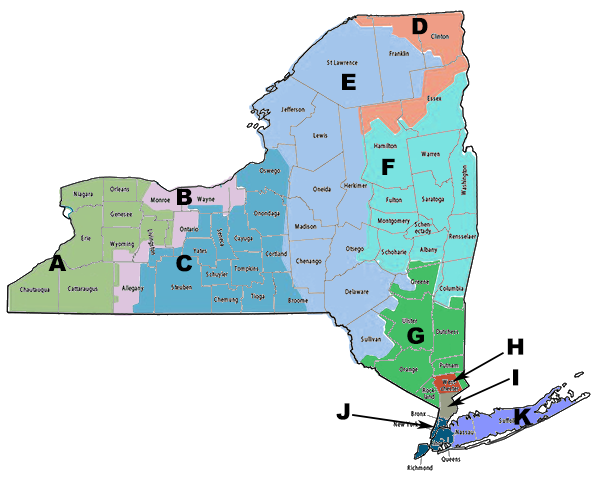
These load zones directly affect your electricity rates:
- New York electric utilities can operate in more than one load zone.
- For example, Orange and Rockland serves Zone G.
- Both supply and delivery rates can be different in each zone. That means the rates you pay for your electricity will depend on which zone you live in.
What Are Orange and Rockland PTC Charges?
When deregulation began in New York, all utilities that wanted to participate in consumer choice had to sell off their generators and limit their business to energy delivery. However, the NY PSC requires these utilities to provide electricity supply at a default rate to customers in their service territory who don't shop for a retail supplier. As a result, these utilities must purchase their electricity supply for the default rate from generator companies.
The NY PSC oversees Orange and Rockland's default service rates since these represent generation supply costs that are passed directly through the utility onto their customers without mark up. This default rate is also called the "Price to Compare" or PTC.
Price to Compare (PTC)
The PTC default rate represents the actual price (generation + transmission) the utility pays for the electricity. In other words, it not only includes the generator company's price for making the electricity but also the cost to transmit it from power stations over high tension power lines to Orange and Rockland's local electrical switch yards. From there, the electricity is distributed throughout the Orange and Rockland local electrical grid for delivery to homes.
Orange and Rockland's PTC rate is composed of the Market Supply Charge. This rate is based upon market conditions during the billing period and will vary depending on where you live or do business. The Orange and Rockland supply charge varies based on forecasted daily market prices. Consequently, the PTC monthly bill rates changes monthly. There are also other charges which include the Merchant Function Charge, the Clean Energy Standard Supply Surcharge, the Electricity Supply Reconciliation Mechanism, and other surcharges that add to the cost.
Because electricity demand fluctuates due to seasonal weather, Orange and Rockland's Supply charge rates can also vary seasonally; low some months, higher the next -- especially in summer when air conditioning usage can soar. With the default PTC rate, you can never be too sure what you'll pay from one month to the next.
Orange and Rockland Current PTC Standard Residential Rates:
- 7.750 cents per kWh, expires 7/31/2025
How Much Do Orange and Rockland Charges Cost?
The US Energy Information Agency reports that in 2019 New York State's residential customers used an average of about 577 kWh each month.
Orange and Rockland's current tariff charges a summer rate delivery rate from June through September. Note that delivery rate is 8.711 cents for the first 250 kwh; then 10.494 cents per kWh over 250 kWh.
With that in mind, an average Orange and Rockland residential PTC bill for most of the year roughly breaks down like this:
| Rate per 577 kWh Used | Monthly Customer Charge | Total | |
| PTC Supply Rate (excluding MFC and other surcharges) |
7.750 cents | 0 | $44.72 |
| Monthly Distribution Charges (excluding riders and other surcharges) |
$0.08711 per kWh* | $19.50 | $67.76 |
| Total Bill | $112.48 |
Understand New York Energy Choice
New York electric consumers are free to choose to buy electricity from Energy Service Companies (ESCOs). These alternative suppliers shop deals with different electricity generators on the wholesale market to offer competitive rates. As such, their rates are not controlled by NY PSC nor do they include the same complicated supply surcharges that Orange and Rockland does in its monthly PTC rate. This way, ESCOs are able to offer competitively priced fixed rate plans for a variety of term lengths.
Though it can seem confusing, shopping electricity plans is an easy process. The trick is finding the one that meets your needs. That's why retail energy suppliers in New York offer two types of plans:
Your Energy Usage and Your Orange and Rockland Bill
While your energy usage habits are unique to you, any upstate New York native will tell you that winters can be bitterly cold and summers can be hot, hazy, and humid. While your biggest energy usage will usually follow the weather, all those other domestic activities, like cooking and cleaning, also add more to your monthly bill.
- While most NY homes rely on natural gas for heating, only 12.2% of homes in the state rely on electricity for heat.
- New York residents spend on average 5% of their annual energy costs on air conditioning. About 53% of NY households have window or wall-mounted AC systems while only 20% have central AC.
- Approximately one third (32%) of home electricity usage goes to electronics, lighting, appliances, and air conditioning.
- The remainder of energy use goes to water heating, refrigeration, lighting, electronics, clothes dryers, cooking, and small appliances.
Want to learn more about your home energy usage? Orange and Rockland customers can track 12 months of their home's electric usage plus other relevant information on each monthly bill or by logging on to your Orange and Rockland account.
The most effective way to cut your energy bills is to reduce your usage by sealing your doors and windows against winter and summer drafts. Adding insulation to your attic, sealing and insulating your basement, and purchasing a programmable or smart thermostat also improve your home's energy efficiency and help cut your electric bills. Your utility company can provide a wealth of resources and may offer programs to help you improve your home's energy performance.
Understand Your Orange and Rockland Bill
The regular residential Orange and Rockland bill contains many details that can be confusing to customers. However, there's lots of useful information to help you better understand your usage and what actually goes into your Orange and Rockland rates. Below, we summarize the most important items you need to understand on a sample Orange and Rockland Electric bill.
Orange and Rockland Sample Bill
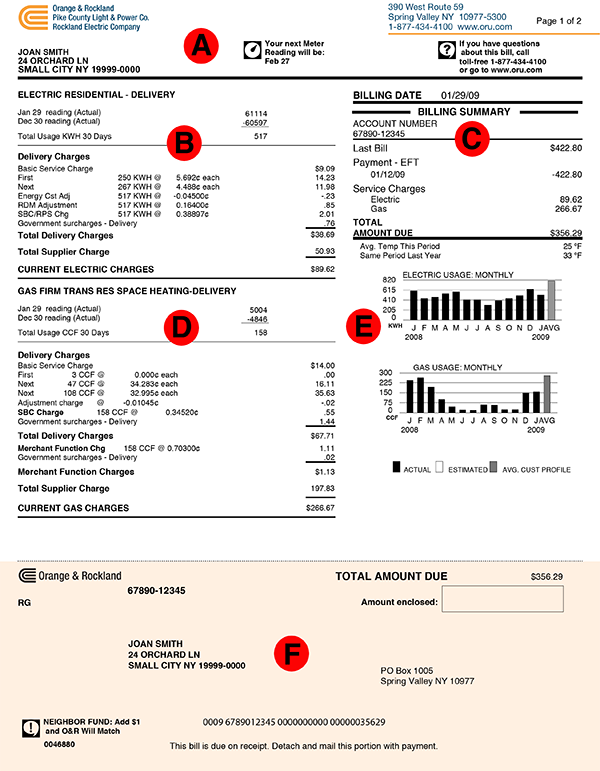
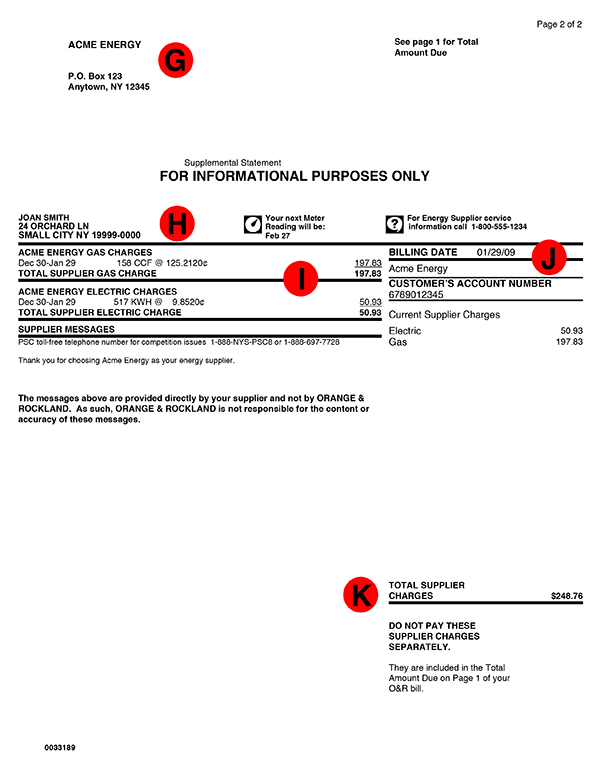
- A: Name and Service Address. This section shows the name and service address for the billing statement. It also shows next meter read date and Orange and Rockland Customer Service contact information.
- B: Electricity Delivery Summary. This section shows your current electricity usage totals, a break down of the Orange and Rockland electricity delivery charges (cents per kWh) and the total supplier charges due.
- C: Billing Summary. This portion displays the billing date and your Orange and Rockland 10-digit account number. It then details the amount due on the previous bill and the amount and date it was paid. It then shows the current service charges for electricity and gas.
- D: Natural Gas Delivery Summary. Similar to deregulated electricity, Orange and Rockland also delivers natural gas and offers default supply service for natural gas. Likewise, customers can also shop for an alternative natural gas supplier. Usage amounts are in hundred cubic feet (ccf). This section shows your current natural gas usage totals. It breaks down the Orange and Rockland natural gas delivery charges in cents per CCF and the total supplier charges due.
- E: Electricity and Natural Gas Usage Monthly. The tables in this portion show your energy usage for the past 13 months. By comparing the most recent period to the same period last year, customers can get an idea of their energy usage and how energy efficient their home is.
- F: Orange and Rockland Bill Pay Stub. This section shows the service address and the mailing addres to return this stub with your payment if you pay Orange and Rockland by mail. To the left, it displays your customer account number. To the right, it shows the total amount due. Be warned that if 20 days have passed since a bill payment was due and you have not paid your bill, the utility can add to your next bill a late payment charge of 1.5% per month on the unpaid balance of your bill.
- G: Electricity Supplier Information. This page details the cost for your electricity supply from either your ESCO or for Orange and Rockland's default PTC supply service.
- H: Energy Supply Charges. This shows the name and service address served by the ESCO as well their Customer Service contract number.
- I: Supply Charges Detail. This section shows the dates and the rate for electricity or natural gas consumed at the service address.
- J: Supply Billing Information. Displays the billing date, the name of the supplier, and the customer account number. It also summarizes the total supply charges.
- K: Supply Charge Total. Adds up the total amount due for the energyl supply portion of your bill.
Compare Orange and Rockland Rates
Orange and Rockland Coupons, Energy Promotions, Discounts, Rebates and Promo Codes
As your local electric utility, Orange and Rockland offers several rebate and energy efficiency programs to help customers save money off their monthly bill by upgrading their home's energy performance. Some programs also offer money-saving incentives while others could make paying your monthly bills much easier during those expensive winter and summer months.
| Program Name | Program Type | Benefit |
| Clean Heat Rebate Program | Energy Efficiency Rebate Programs | Orange and Rockland residential customers can take advantage of generous rebates on the purchase of high efficiency heating and cooling systems, including geothermal, heat pumps, central air conditioning, ductless systems, and water heating.
|
| Appliance Rebate Program | Energy Efficiency Rebate Program | Custmers can also find savings on energy-efficient lighting, smart thermostats, water-saving solutions, power strips, air filters, smart home devices and electric vehicle charger by shopping the Orange and Rockland Smart Solutions on-line store. |
| Residential Energy Assessment & Upgrades | Sealed Energy Efficiency Programs | Sealed has teamed Orange and Rockland to help qualifying customers receive rebates to help improve your home's energy efficiency.
|
| Orange and Rockland Payment Arrangements | Bill payment assistance | Orange and Rockland offers payment arrangements to allow residential customers to pay their account balance while remaining connected. There are payment plans with no down payment, fees or interest available.
|
| Home Energy Assistance Program (HEAP) Grants | Bill payment assistance | HEAP provides both regular and emergency financial grants to eligible households to help pay heating and/or utility bills. HEAP benefits are funded by the federal government and administered through the New York state Department of Social Services. Orange and Rockland customers who receive a HEAP benefit during the HEAP season will be issued a monthly bill credit on their Orange and Rockland bill for a maximum of 12 months based on service type. Energy Assistance Program (EAP) is designed to help eligible customers gain control of their energy bills. It has two levels of assistance, bill credits and arrears forgiveness. EAP bill credits are available automatically to any customer who receives a HEAP benefit. A limited number of EAP participants can apply for the EAP arrears forgiveness program.
|
| Em-Power New York Energy Efficiency Upgrades | Residential Energy Efficiency | Orange and Rockland has partnered with New York State Energy Research and Development Authority (NYSERDA) to offer HEAP qualified customers no-cost energy efficiency upgrades to help reduce their electric bills.
|
Read Orange and Rockland Reviews
Since Orange and Rockland serves a midsize east coast market segment, New York residential customers throughout the state can get a better picture of how good a job it does by comparing it to similar sized utilities. While Orange and Rockland is not accredited with the BBB, the utility ranked about average in J.D. Power's 2020 utility residential customer satisfaction study.
| NY Energy Ratings Score | Better Business Bureau | J.D. Power 2020 Electricity Utility Study |
| N/A | Not Accredited, F |
693 of 1000 pts |
How Do I Get the Cheapest Orange and Rockland Rate?
Shopping for a new Orange and Rockland Customer Choice Plan can seem bewildering at first. Once you understand how it works, though, it's an easy and straightforward process. That said, you should have these three things with you when you shop for electricity.
- Your current bill. Your past usage per billing period can help you estimate a how much a plan might cost you each month.
- The current Orange and Rockland PTC rate. Knowing the current Orange and Rockland supply price lets you compare rates offered by retail energy suppliers. This way, you can get a better feel for what suppliers are offering, for how long, and if any of their incentives make their price work for your family's need.
- Your Orange and Rockland customer account number. This is the 10 digit account number found on both page 1 and page 2 of your bill. Having this handy lets you sign up with a retail supplier right away.
Orange and Rockland Shopping Questions
The best way for a NY energy customer to avoid making a bad choice it to ask the right questions. That way, you can learn exactly the information that can save you money. When you shop for electricity service in New York, always be sure to ask these important questions:
- Is the rate variable or is it fixed?
- How long does the plan contract term run?
- Does the plan include any recurring monthly charges?
- Is the rate competitive with the current Orange and Rockland supply rate annual average? Remember that Orange and Rockland's rate changes monthly!
- Does the plan have an early cancellation fee?
- Does the supplier offer any customer incentives or rewards programs?
- What happens when the contract with the ESCO expires?
Other Commonly Asked New York Electricity Questions:
Who bills me? Orange and Rockland sends a single bill that outlines and adds up your monthly charges.
What are the Terms of Service? In NY, Customer Choice Plans must include Terms of Service that explain and identify specific charges and any fees a customer will face when they sign up for an electricity plan. Not all suppliers have the same terms. That's why all New York energy choice customers should read and understand the terms of service and contract summary for any plan they are interested in before they sign on to the plan.
What is the Right of Rescission? According to the New York ESCO Consumers Bill of Rights, residential customers have the right to rescind or cancel an agreement with an ESCO within three days of receiving the agreement without facing a penalty.
What are early termination fees? Switching retail suppliers before a contract ends can involve paying early termination fees. These can take a big chomp out of your checking account you if choose to switch retail providers before your plan contract ends.
Where can I find more information on my usage? Orange and Rockland customers can request 12 months of their energy usage free of charge. This is most easily available through your Orange and Rockland online account.
Read Orange and Rockland Customer Reviews
Compare Orange and Rockland Electricity Rates in Your Area
Bill Questions? Electricity Out? Contact Orange and Rockland!
Having problems or interruptions with your Orange and Rockland electricity? Here's the proper people to call.
Orange and Rockland Billing Problems
First thing to do is contact Orange and Rockland Customer Service at 1-877-434-4100 and learn what options you have. If you are having trouble paying your monthly bill then call Orange and Rockland's Bill Payment Center:1-888-315-1755. Have your account number ready. You can also apply for payment methods online through your Orange and Rockland account.
Important Billing Options to keep in mind:
- Budget Billing: The NY PSC requires all New York public utilities to offer "budget billing" where annual electricity costs are averaged out over the cost of the year. This ensures that customers aren't presented with unexpectedly high bills at peak times.
- Need Extra Time? If you need extra time to pay your bill, just log in to your account and request an extension of up to 10 days. If you're at least 60 years of age or on a fixed income, you may qualify for a bill extender and receive special protection from late payment charges. A bill extender allows you to extend the due date on your energy bill up to 45 days after the billing date.
Orange and Rockland Emergencies and Outages
All power lines are extremely dangerous! Never attempt to move a downed power line by yourself. Call 911 and then notifiy Orange and Rockland.
- Report downed powerlines and other safety hazards immediately to Orange and Rockland at 1-877-434-4100.
- For natural gas emergencies or if you smell a natural gas odor, get up, get out and get away! Then immediately call Orange and Rockland at 1-800-533-LEAK (5325) or 911 from a safe location.
- You can also report downed lines or outages at Orange and Rockland's website.
- Check Orange and Rockland's current electric outages as they are being repaired.
Orange and Rockland Service Area Providers
| Company | Rating | Phone |
|---|---|---|
| Frontier Utilities | (3.4/5) |
|
| Direct Energy | (3.3/5) |
(866) 645-2643 |
| Constellation | (3.3/5) |
855-798-9075 |
| Spark Energy | (3/5) |
(866) 605-8658 |
| Major Energy | (2.9/5) |
(866) 607-4735 |
| Verde Energy | (2.8/5) |
|
| Kiwi Energy | (0/5) |
|
| Spring Power & Gas | (0/5) |
|
| 8 results | ||
New York Zip Codes with the Cheapest Electricity Rates
The Latest Orange and Rockland News
No. Each of New York’s investor-owned utilities (IOU) face unique conditions for distributing and transmitting power to customers in their area. For example, while National Grid must build... [read more]